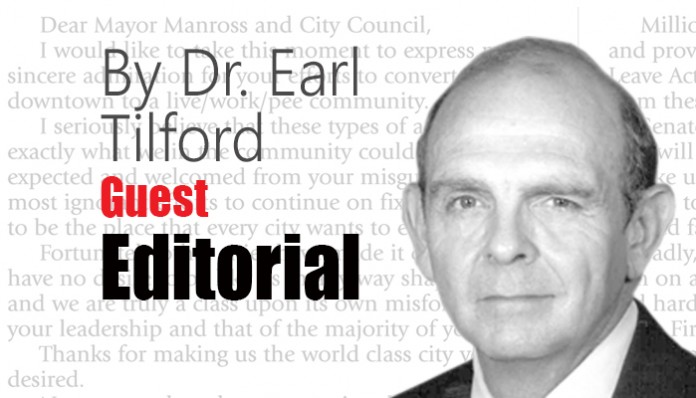Guest Editorial
Recent revelations by the Pentagon’s inspector general indicates that U.S. Central Command, which bears responsibility for military operations in the Middle East, altered intelligence analyses to support the Obama administration’s contention that limited air strikes have “contained ISIS.” If so, that’s unfortunately nothing new. Politically skewed intelligence has a history.
In November 1967, President Lyndon Johnson ordered Gen. William Westmoreland, Military Assistance Command for Vietnam (MACV), home for a public relations tour. Facing re-election in 1968, Johnson needed another term to implement his Great Society. He needed Westmoreland to reassure a war-weary public and bolster his upcoming re-election campaign.
Starting in 1966, MACV conducted massive ground sweep operations compiling impressive “quantitative” victories; these victories focused on obtaining body counts of 10-enemies-to-one-American. Numbers of enemy dead, wounded, and captured, plus compilations of weapons and rice caches captured, along with expanded secure areas within South Vietnam, were all considered indications of progress.
During his “victory tour,” Westmoreland told a joint session of Congress that the war would be won by 1970. He repeated the story on CBS’s “Face the Nation.” Assured by Westmoreland that there was “light at the end of the tunnel,” Time magazine named Lyndon Johnson 1967’s “Man of the Year.”
Two months later the Viet Cong—backed by North Vietnamese forces—launched attacks in 38 of South Vietnam’s 44 provincial capitals. During the Tet Offensive, the enemy struck American and South Vietnamese military headquarters in Saigon and broached the U.S. embassy outer compound. The North Vietnamese Army captured the ancient imperial capital at Hue, holding if for a month. Almost 4,000 American soldiers and Marines, along with 5,000 South Vietnamese troops, were killed in the fighting. An estimated 15,000 South Vietnamese citizens also died. The administration’s optimistic assertions heightened the devastating impact on the public’s will to continue the struggle.
On March 31, 1968, rather than lose the Democratic nomination to Robert Kennedy, LBJ withdrew from the campaign. Johnson’s dreams of a “Great Society” died, along with American soldiers—needless victims of intelligence skewed to satisfy Johnson’s domestic political agenda.
During the 1968 presidential campaign, Republican Richard Nixon touted a “secret plan to end the war” during his first term. After eeking out a close victory, Nixon and National Security Advisor Henry Kissinger unveiled “Vietnamization,” a plan to slowly turn the war back to the South Vietnamese while withdrawing U.S. forces. American air power, including secret bombing of Cambodia and intensification of the bombing of the Ho Chi Minh Trail in Laos, Operation Command Hunt, would cover the withdrawal.
Nixon feared another Tet-style offensive might jeopardize withdrawal. In May, Nixon ordered U.S. troops into communist sanctuaries in Cambodia where they stayed for two months.
Vietnamization continued. Then in February and March 1971, U.S. air power supported an Army of the Republic of Vietnam (ARVN) invasion of Laos to cut the Ho Chi Minh Trail. Operation Lam Son 719 was a debacle that cost half the lives of half the 15,000-man ARVN invading force, 108 U.S. Army helicopters shot down, and 289 American lives. Nevertheless, Nixon dubbed Lam Son 719 “South Vietnam’s greatest victory so far.” Vietnamization continued and so did skewed intelligence.
To support the Nixon administration’s Vietnamization policy, U.S. Air Force intelligence depicted Commando Hunt as an air-power success with 85 percent of enemy supplies and troops entering the Ho Chi Minh Trail never reaching South Vietnam. Air Force and the Defense Intelligence Agency claimed Commando Hunt destroyed thousands of North Vietnamese trucks. These were lies to support the efficacy of Vietnamization.
Things looked so good by late March 1972 that the American ambassador to South Vietnam, Ellsworth Bunker, was in Nepal spending Easter week with his wife, the ambassador to Katmandu. MACV commander Gen. Creighton Abrams traveled to Bangkok to celebrate Easter Sunday with his family.
Air Force intelligence—chocked full of optimism—didn’t tally when on Wednesday, March 29, 1972, ten North Vietnamese and two Viet Cong Divisions (mostly composed of North Vietnamese) invaded South Vietnam. The South Vietnamese military, massively backed by U.S. air power, eventually contained the invasion during Operation Linebacker, the most effective aerial interdiction operation of the war.
In January 1973, the warring parties signed a treaty allowing the withdrawal of U.S. remaining forces. North Vietnam released 591 American prisoners of war. Two years later, in less than three months, a North Vietnamese invading force reunited Vietnam under a communist regime.
It took a generation after all of this to rebuild trust in the U.S. military.
Today, false claims that limited air strikes are working on ISIS track with the facile assertion that an Internet video prompted the September 11, 2012 Benghazi murders of U.S. Ambassador Christopher Stevens and three other heroic Americans. Lying in matters of national security, especially to support partisan political ends, can be deadly and is worsened by its callously self-serving nature.
Dr. Earl Tilford is a military historian and fellow for the Middle East & terrorism with The Center for Vision & Values at Grove City College. From 1993 to 2001, he served as Director of Research at the U.S. Army’s Strategic Studies Institute.





